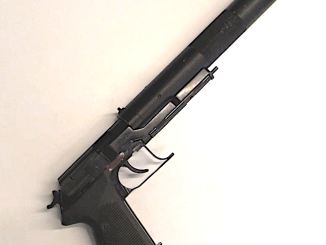The Bechowiec (or Beha) is a fascinating SMG produced in small numbers in southern Poland under German occupation during World War Two. It was made for use by the Bataliony Chłopskie (Peasant Battalions) by a young man named Henryk Strąpoć.
Henryk built his first (quite illegal) gun at the age of 15 in 1937, and was promptly arrested for it. He avoided prison only on account of being a minor, and promised not to do it again. Well, at least he promised not to get caught again – he built three more guns (two semiauto pistols and a revolver) by the time Germany invaded Poland in 1939. During the occupation he joined the the resistance and set to work doing what he must have fantasized about; building clandestine small arms.
Being more or less familiar with pistols but having never handled a submachine gun, he made some creative design choices. His SMG is basically a scaled-up Ruby-type action – chambered for 9x19mm with a simple blowback slide, it is hammer fired from a closed bolt. He designed a complex but effective selective-fire trigger system, complete with a correct auto sear. The first gun was ready in the spring of 1943, and he had a makeshift production going by early 1944. A total of 11 of the guns were made by July 1944, some in 9mm (using bored-out WW1 Mauser barrels) and some in 7.62x25mm Tokarev (using Mosin Nagant barrels).
Only one example survives today, and it is housed in the Polish Army Museum (and sadly, deactivated). Many thanks to the Museum for giving me access to film it for you! Check them out at: http://www.muzeumwp.pl/?language=EN



What happened to him after the war?
https://pl.wikipedia.org/wiki/Henryk_Str%C4%85po%C4%87 claims that
Po zakończeniu wojny uczęszczał do szkoły mechanicznej w Sławięcicach.
which after translation gives
After the end of the war, he attended a mechanical school in Sławięcice
and Krzyż Partyzancki https://en.wikipedia.org/wiki/Krzyż%20Partyzancki was awarded to him.
Being a closed bolt hammer fired smg, this thing was waaay ahead of its time, a real firearms development delight.
Its insane the bureaucrats perceive the only example of this historical gun as such a threat, it should be deactivated.
They utterly miss the point, of course. It’s not this particular gun behind alarmed glass in a museum locked at night with guards that’s a threat – it’s the capability that people 80 years ago under Nazi occupation with the Gestapo looking for them could still produce fully automatic sub-machine guns that is a threat.
Whatever keeps the EU awake and worried at night is good for man’s kinds.
Your a hero when you do it when there is a enemy a criminal at other times ,
that was awesome. kudos (then) young man!
One can only salute the young man. In Turkey we would say Kutlariz – we celebrate you
Is it rifled?
Its made from RIFLE barrels.
I caught that but Ian said it was WW1 Mauser rifle barrels which would be 8mm. He also stated they were chambered in 9mm which means unless they were rerifled they are now smooth bores.
According to https://www.forgottenweapons.com/polish-beha-resistance-smg/
…barrel is 240 mm (9.45 in) long, with 6 grooves, right hand twist rifling, one turn in 224 mm (8.82 in)…
Section of the BH submachine gun drawing shows barrel to be rifled.
These suggest that barrels of 9×19 mm version were bored-out and then rifled again.
Yet another marker for the essential futility of trying to disarm human beings. Once the idea is out there, the weapons will follow.
I find myself wondering, sometimes, if there were tribal elders deep in our history who were similarly trying to outlaw knapped flint in certain patterns, “for the children”.
I rather suspect that if there were, they went extinct shortly after they came up with the idea.
“(…)more or less familiar with pistols but having never handled a submachine gun, he made some creative design choices(…)”
This seems to parallel actions of EVELYN OWEN, which crafted .22 rim-fire sub-machine gun
https://www.historicalfirearms.info/post/156736794685/evelyn-owens-first-prototype-chambered-in-22
which used revolver-like feed system giving capacity 44.
Henryk Strąpoć’s first self-made weapon was a shotgun, which he had constructed at the age of 13. He followed it at age 15 with the oft-mentioned semi-automatic pistols, which resulted in a visit by a policeman, the confiscation of the constructions, and the promise: “Next time I’ll confiscate you as well, boy!”. When the war broke out, he actually did not stop at his most famous creation: in addition to bechowiec, he also made grenades and even land mines. Before building the first bechowiec, he would sit down in places where Feldgendarmerie patrols armed with MP-40s would regularly walk, and he would watch their weapons, return home, sketch their details from memory, and attempt to guess by their shapes how they worked.
In the 70s, when a reporter for a local periodical from Kielce visited him in his village to seek an interview, Strąpoć, with considerable excitement, told him in detail how to construct those – understandably, the printed article omitted those explanations.
Henryk Strąpoć’s first self-made weapon was a shotgun, which he had constructed at the age of 13. He followed it at age 15 with the oft-mentioned semi-automatic pistols, which resulted in a visit by a policeman, the confiscation of the constructions, and the promise: “Next time I’ll confiscate you as well, boy!”. When the war broke out, he actually did not stop at his most famous creation: in addition to bechowiec, he also made grenades and even land mines. Before building the first bechowiec, he would sit down in places where Feldgendarmerie patrols armed with MP-40s would regularly walk, and he would watch their weapons, return home, sketch their details from memory, and attempt to guess by their shapes how they worked.
In the 70s, when a reporter for a local periodical from Kielce visited him in his village to seek an interview, Strąpoć, with considerable excitement, told him in detail how to construct those – understandably, the printed article omitted those explanations.